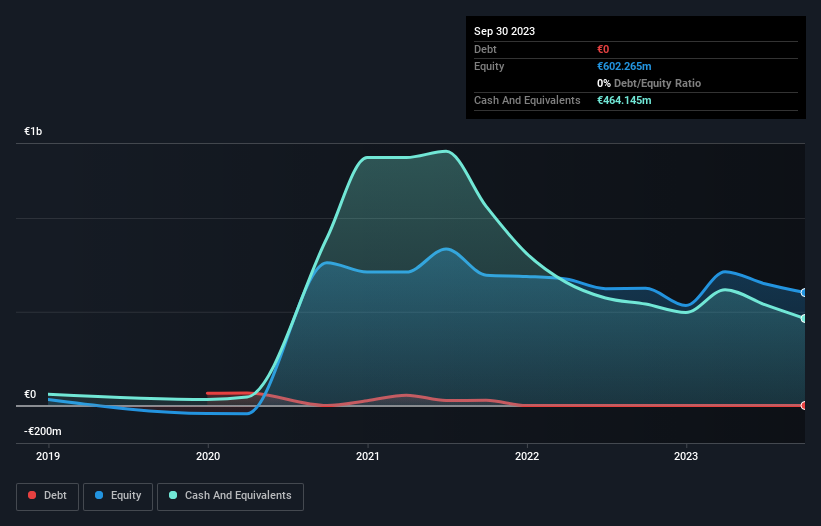- United States
- /
- Biotech
- /
- NasdaqGM:CVAC
We Think CureVac (NASDAQ:CVAC) Needs To Drive Business Growth Carefully

We can readily understand why investors are attracted to unprofitable companies. For example, biotech and mining exploration companies often lose money for years before finding success with a new treatment or mineral discovery. Having said that, unprofitable companies are risky because they could potentially burn through all their cash and become distressed.
So, the natural question for CureVac (NASDAQ:CVAC) shareholders is whether they should be concerned by its rate of cash burn. In this report, we will consider the company's annual negative free cash flow, henceforth referring to it as the 'cash burn'. Let's start with an examination of the business' cash, relative to its cash burn.
View our latest analysis for CureVac
How Long Is CureVac's Cash Runway?
You can calculate a company's cash runway by dividing the amount of cash it has by the rate at which it is spending that cash. As at September 2023, CureVac had cash of €464m and no debt. Looking at the last year, the company burnt through €335m. Therefore, from September 2023 it had roughly 17 months of cash runway. Importantly, analysts think that CureVac will reach cashflow breakeven in 4 years. Essentially, that means the company will either reduce its cash burn, or else require more cash. Depicted below, you can see how its cash holdings have changed over time.

How Well Is CureVac Growing?
It was fairly positive to see that CureVac reduced its cash burn by 37% during the last year. In contrast, however, operating revenue tanked 56% during the period. In light of the data above, we're fairly sanguine about the business growth trajectory. While the past is always worth studying, it is the future that matters most of all. For that reason, it makes a lot of sense to take a look at our analyst forecasts for the company.
How Easily Can CureVac Raise Cash?
While CureVac seems to be in a fairly good position, it's still worth considering how easily it could raise more cash, even just to fuel faster growth. Companies can raise capital through either debt or equity. Many companies end up issuing new shares to fund future growth. By comparing a company's annual cash burn to its total market capitalisation, we can estimate roughly how many shares it would have to issue in order to run the company for another year (at the same burn rate).
Since it has a market capitalisation of €606m, CureVac's €335m in cash burn equates to about 55% of its market value. From this perspective, it seems that the company spent a huge amount relative to its market value, and we'd be very wary of a painful capital raising.
Is CureVac's Cash Burn A Worry?
Even though its falling revenue makes us a little nervous, we are compelled to mention that we thought CureVac's cash burn reduction was relatively promising. One real positive is that analysts are forecasting that the company will reach breakeven. Summing up, we think the CureVac's cash burn is a risk, based on the factors we mentioned in this article. Readers need to have a sound understanding of business risks before investing in a stock, and we've spotted 1 warning sign for CureVac that potential shareholders should take into account before putting money into a stock.
Of course, you might find a fantastic investment by looking elsewhere. So take a peek at this free list of interesting companies, and this list of stocks growth stocks (according to analyst forecasts)
New: AI Stock Screener & Alerts
Our new AI Stock Screener scans the market every day to uncover opportunities.
• Dividend Powerhouses (3%+ Yield)
• Undervalued Small Caps with Insider Buying
• High growth Tech and AI Companies
Or build your own from over 50 metrics.
Have feedback on this article? Concerned about the content? Get in touch with us directly. Alternatively, email editorial-team (at) simplywallst.com.
This article by Simply Wall St is general in nature. We provide commentary based on historical data and analyst forecasts only using an unbiased methodology and our articles are not intended to be financial advice. It does not constitute a recommendation to buy or sell any stock, and does not take account of your objectives, or your financial situation. We aim to bring you long-term focused analysis driven by fundamental data. Note that our analysis may not factor in the latest price-sensitive company announcements or qualitative material. Simply Wall St has no position in any stocks mentioned.
About NasdaqGM:CVAC
CureVac
A biopharmaceutical company, focuses on developing various transformative medicines based on messenger ribonucleic acid (mRNA).
Adequate balance sheet with moderate growth potential.


